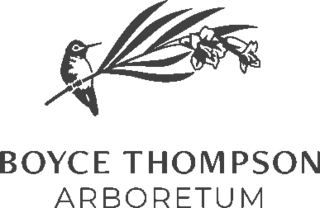
The Great Basin is the largest area of contiguous endorheic watersheds, those with no outlets, in North America. It spans nearly all of Nevada, much of Utah, and portions of California, Idaho, Oregon, Wyoming, and Baja California. It is noted for both its arid climate and the basin and range topography that varies from the North American low point at Badwater Basin in Death Valley to the highest point of the contiguous United States, less than 100 miles (160 km) away at the summit of Mount Whitney. The region spans several physiographic divisions, biomes, ecoregions, and deserts.

Boyce Thompson Arboretum is the oldest and largest botanical garden in the state of Arizona. It is one of the oldest botanical institutions west of the Mississippi River. Founded in 1924 as a desert plant research facility and “living museum”, the arboretum is located in the Sonoran Desert on 392 acres (159 ha) along Queen Creek and beneath the towering volcanic remnant, Picketpost Mountain. Boyce Thompson Arboretum is on U.S. Highway 60, an hour's drive east from Phoenix and 3 miles (4.8 km) west of Superior, Arizona.

An arboretum is a botanical collection composed exclusively of trees of a variety of species. Originally mostly created as a section in a larger garden or park for specimens of mostly non-local species, many modern arboreta are in botanical gardens as living collections of woody plants and is intended at least in part for scientific study.

The San Francisco Botanical Garden at Strybing Arboretum is located in San Francisco's Golden Gate Park. Its 55 acres represents nearly 9,000 different kinds of plants from around the world, with particular focus on Magnolia species, high elevation palms, conifers, and cloud forest species from Central America, South America and Southeast Asia.

Wave Hill is a 28-acre (11 ha) estate in the Hudson Hill section of Riverdale in the Bronx, New York City. Wave Hill currently consists of public horticultural gardens and a cultural center, all situated on the slopes overlooking the Hudson River, with expansive views across the river to the New Jersey Palisades. The estate includes two houses and a botanical garden. The oldest part of the main house, Wave Hill House, dates to 1843; Glyndor House dates from 1927 and contains a multi-room art gallery. Perkins Visitor Center, which was originally a garage, contains a gift shop and an information desk.

Turtle Bay Exploration Park, located in Redding, California, is a non-profit 300-acre gathering place featuring the Sundial Bridge, a museum, forestry and wildlife center, arboretum and botanical gardens. The park is located at gateway to the Sacramento River Trails, Turtle Bay.
The UNLV Arboretum is an 80-acre (32 ha) arboretum on the campus of the University of Nevada, Las Vegas in Paradise, Nevada.
University of Nevada, Reno Arboretum is a state arboretum located across the campus at the University of Nevada, Reno in Reno, Nevada.
The Hayes Arboretum is an arboretum of 330 acres (130 ha) located in Richmond, Indiana, United States. It is open free to the public Tuesdays through Saturdays, 9:00 A.M. to 5:00 P.M. It is the primary project of the Stanley W. Hayes Research Foundation, a private operating foundation. The Foundation owns a total of 466 acres (189 ha) of property in Wayne County, IN.

Las Vegas Springs Preserve consists of 180 acres (73 ha) dedicated to nature walks and displays and is owned and operated by the Las Vegas Valley Water District. The Preserve is located approximately three miles west of downtown Las Vegas, Nevada. The Preserve is built around the original water source for Las Vegas, the Las Vegas Springs.

The Brookside Gardens are public gardens located within Wheaton Regional Park, at 1800 Glenallan Avenue, Silver Spring, Maryland. The gardens are open daily without charge. However, certain annual events there are held that may charge a fee. The gardens hosts a "Garden of Lights" exhibit that features a light display during the holiday season.

Tohono Chul is a botanical garden, nature preserve, and cultural museum located in Casas Adobes, a suburb of Tucson, Arizona. The words "tohono chul" translate as "desert corner" and are borrowed from the language of the Tohono O’odham, the indigenous people of southern Arizona. The mission of Tohono Chul is to connect people with the nature, art and culture of the Sonoran Desert region and to "inspir[e] wise stewardship of the natural world".

Western Nevada (WNV) is a region and the northwestern portion of the U.S. state of Nevada that includes Reno, Carson City, Carson Valley and Virginia City. Lyon County and Churchill County are sometimes also referred to as part of Western Nevada.

Auckland Botanic Gardens is a botanical garden in the New Zealand city of Auckland. It is located in the suburb of Manurewa, in the Manurewa Local Board Area. The gardens cover 64 hectares, and holds more than 10,000 plants.

The Nevada State Museum in Carson City is one of seven Nevada State Museums operated by the Nevada Department of Tourism and Cultural Affairs. The primary building of the museum is the former Carson City Mint. The exhibits include:

Lauritzen Gardens are a botanical gardens and arboretum located at 100 Bancroft Street in the South Omaha neighborhood of Omaha, Nebraska. The gardens are open daily during business hours; an admission fee is charged.
The following is a timeline of the history of the city of Reno, Nevada, United States.

The McConnell Arboretum & Botanical Gardens, also known as the Redding Arboretum, are located within Turtle Bay Exploration Park, in Redding, California. The gardens opened on May 30, 2005, and cover 300 acres, including 200 acres of undeveloped arboretum and 20 acres of botanical garden that span the Sacramento River.














